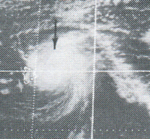1972 Pacific hurricane season
| 1972 Pacific hurricane season | |
|---|---|

Season summary map
|
|
| Seasonal boundaries | |
| First system formed | June 1, 1972 |
| Last system dissipated | November 20, 1972 |
| Strongest storm | |
| Name | Celeste |
| • Maximum winds | 130 mph (215 km/h) (1-minute sustained) |
| • Lowest pressure | 940 mbar (hPa; 27.76 inHg) |
| Seasonal statistics | |
| Total depressions | 20 |
| Total storms | 14 |
| Hurricanes | 9 |
| Major hurricanes (Cat. 3+) |
4 |
| Total fatalities | 1 |
| Total damage | At least $75,000 (1972 USD) |
| Related articles | |
| Category 1 hurricane (SSHWS) | |
| Duration | June 1 – June 8 |
|---|---|
| Peak intensity | 85 mph (140 km/h) (1-min) ≤ 993 mbar (hPa) |
| Tropical storm (SSHWS) | |
| Duration | July 27 – July 30 |
|---|---|
| Peak intensity | 50 mph (85 km/h) (1-min) 993 mbar (hPa) |
| Category 4 hurricane (SSHWS) | |
| Duration | August 6 – August 22 |
|---|---|
| Peak intensity | 130 mph (215 km/h) (1-min) 940 mbar (hPa) |
| Category 2 hurricane (SSHWS) | |
| Duration | August 11 – August 20 |
|---|---|
| Peak intensity | 110 mph (175 km/h) (1-min) 968 mbar (hPa) |
| Category 1 hurricane (SSHWS) | |
| Duration | August 15 – August 22 |
|---|---|
| Peak intensity | 80 mph (130 km/h) (1-min) 1004 mbar (hPa) |
| Category 3 hurricane (SSHWS) | |
| Duration | August 20 – September 1 |
|---|---|
| Peak intensity | 115 mph (185 km/h) (1-min) ≤ 948 mbar (hPa) |
| Category 3 hurricane (SSHWS) | |
| Duration | August 22 – August 31 |
|---|---|
| Peak intensity | 125 mph (205 km/h) (1-min) ≤ 941 mbar (hPa) |
| Category 3 hurricane (SSHWS) | |
| Duration | August 28 – September 7 |
|---|---|
| Peak intensity | 125 mph (205 km/h) (1-min) ≤ 962 mbar (hPa) |
| Tropical storm (SSHWS) | |
| Duration | September 14 – September 22 |
|---|---|
| Peak intensity | 50 mph (85 km/h) (1-min) ≤ 999 mbar (hPa) |
The 1972 Pacific hurricane season was an ongoing event in tropical cyclone meteorology. There were few notable storms this year. No one was killed and storm effects were generally not serious. The most notable systems were Hurricane Celeste and Joanne. Celeste was the strongest storm of the season, and caused heavy damage to Johnston Atoll. Hurricane Joanne brought gale-force winds to the Continental United States and caused flooding in Arizona and northern Mexico, which killed one person. The only other system to directly impact land was Hurricane Annette.
The season began on May 15, 1972, in the east Pacific, and on June 1, 1972, in the central Pacific. It ended on November 30, 1972. These dates conventionally delimit the period of time when tropical cyclones form in the east Pacific Ocean. This season had a below average number of storms. There were twenty tropical cyclones, four of which were in the central Pacific. Of those, four were tropical storms, eight were hurricanes, and four were major hurricanes that reached Category 3 or higher on the Saffir-Simpson Hurricane Scale. In the central Pacific, two tropical storms and two tropical depressions formed. One of the depressions and one of the storms crossed the International Date Line to become typhoons in the 1972 Pacific typhoon season.
Of this season's fourteen named tropical cyclones, twelve formed in the eastern Pacific and two in the central. Both central Pacific tropical cyclones were tropical storms. Of the eastern Pacific systems, four were tropical storms and eight were hurricanes. Of those eight hurricanes, four were major hurricanes because they peaked as Category 3 or higher on the Saffir-Simpson Hurricane Scale. Although these totals are below the modern long-term averages of fifteen named storms, nine hurricanes, and four major hurricanes, At the time, 1972 was the central north Pacific's busiest known season.
On June 1, a tropical disturbance organized into a tropical storm. It slowly moved north and then recurved to the northeast as it accelerated slightly. It intensified into a hurricane on June 4. It remained at that strength for one day. Annette then began weakening. As a tropical storm, Annette made landfall in southeast of Manzanillo on June 7. The next day, it dissipated inland.
...
Wikipedia


















